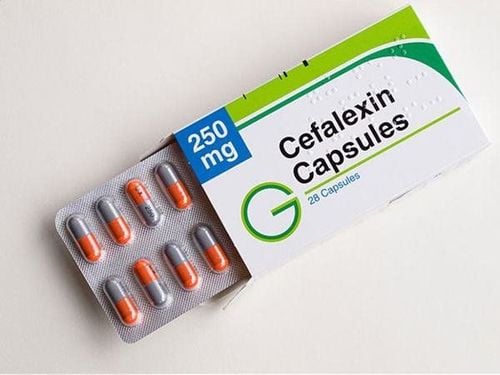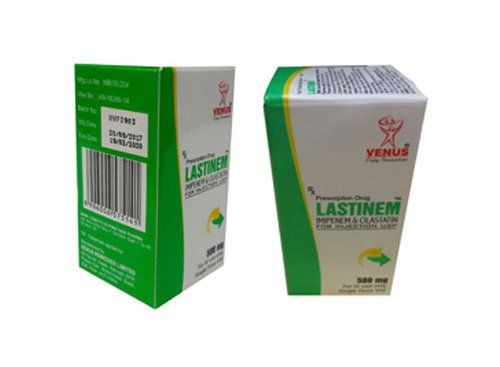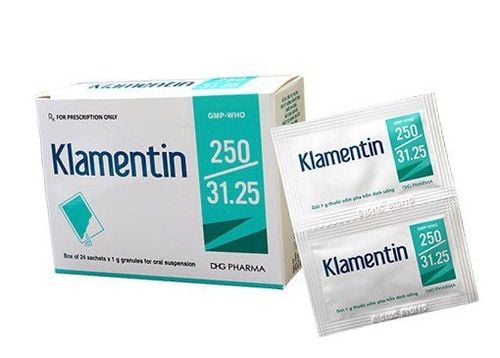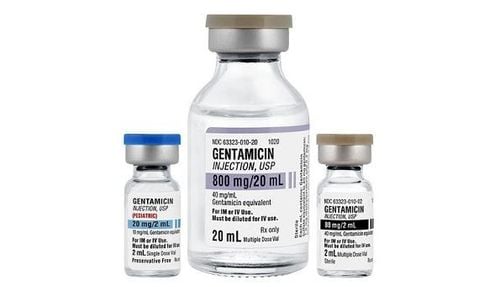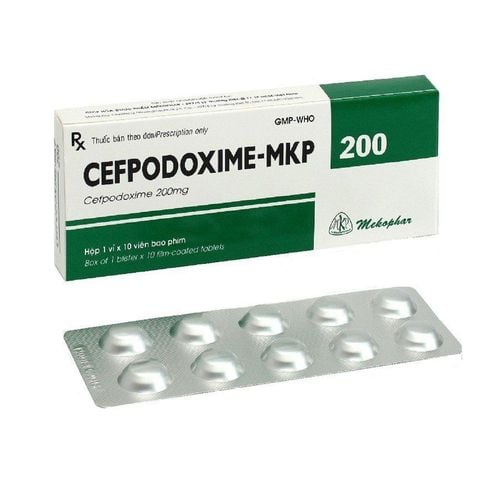This is an automatically translated article.
What is Alpenam? Alpenam medicine 500mg is used in the treatment of infections with the main ingredient is Meropenem. Let's find out more details about the uses, usage and notes when using Alpenam 500mg through the article below.
1. Indications for taking Alpenam
Alpenam 500mg drug is used intravenously to treat infections in adults and children caused by 1 or more bacteria sensitive to Meropenem such as:
Nosocomial pneumonia and pneumonia. Urinary tract infection. Intra-abdominal infection. Gynecological infections (endometritis) and pelvic inflammatory diseases. Skin and skin structure infections. Meningitis. Sepsis . Treatment of adult suspected febrile febrile neutropenia as monotherapy or in combination with antiviral or antifungal agents.
2. Dosage - How to take Alpenam 500mg
Alpenam 500mg is used intravenously. Dosage of Alpenam refer to the following:
Adults:
Dosage and duration of Meropenem treatment depends on the severity and type of infection as well as the condition of each patient.
The recommended daily dose of Meropenem is as follows:
Use 500mg Meropenem intravenously (IV) every 8 hours in the treatment of pneumonia, gynecological infections (endometritis), urinary tract infections, infections skin bacteria and skin structure. Use 1g of Meropenem intravenously (IV) every 8 hours in the treatment of suspected bacterial infections in patients with leukopenia, sepsis, hospital-acquired pneumonia, and peritonitis. For the treatment of cystic fibrosis, doses up to 2g of Meropenem per 8 hours have been used; Most patients were treated with 2g Meropenem every 8 hours. For the treatment of meningitis, the recommended dose is 2g Meropenem every 8 hours. Patients with impaired renal function:
The dose should be reduced for patients with creatinine clearance < 51 ml/min as follows:
Creatinine from 26-50 ml/min: Dosage (calculated in dose units of 500 mg, 1 g, 2 g): 1 unit dose, every 12 hours. Creatinine from 10-25 ml/min: Dosage (calculated in dose units 500 mg, 1 g, 2 g): half a unit every 12 hours. Creatinine < 10 ml/min: Dosage (in dose units 500 mg, 1 g, 2 g): half a unit every 24 hours. Patients with hepatic impairment: No dose adjustment of Alpenam 500mg is required.
Elderly: No dose adjustment of Meropenem is required for elderly patients with normal renal function or with creatinine clearance > 50ml/min.
Children:
Children 3 months - 12 years: The recommended dose is 10-20 mg Meropenem/kg every 8 hours depending on the severity, susceptibility and type of infection of the causative agent and the patient's condition. . Children > 50 kg: The same dose of Meropenem is recommended as in adults. The recommended dose for meningitis is 40 mg Meropenem/kg every 8 hours. There is no experience using Alpenam 500mg for children with renal failure. Unintentional Meropenem overdose may occur during treatment, especially in patients with renal impairment. Treatment of Meropenem overdose should be symptomatic. In normal subjects, Alpenam is rapidly eliminated by the kidneys; In patients with renal impairment, hemodialysis removes meropenem and its metabolites.
3. Contraindications to taking Alpenam
Alpenam 500mg should not be used in the following cases:
Patients with hypersensitivity to Meropenem. The patient is allergic to the active substance, to any other Carbapenem antibacterial agent or to any of the excipients in the drug. Patients with severe hypersensitivity, such as anaphylaxis, severe skin reactions, to any other type of beta-lactam antibacterial agent such as penicillin or cephalosporin.
4. Side effects of drugs
The following side effects reported in clinical trials have been reported:
Pain at the injection site, inflammation, thrombophlebitis at the injection site. Systemic allergic reactions such as hypersensitivity, angioedema, and anaphylaxis have been reported rarely with the use of Meropenem. Skin reactions: Pruritus, rash, urticaria, erythema multiforme, Stevens-Johnson syndrome and toxic epidermal necrolysis have been reported rarely. Gastrointestinal: Diarrhea, abdominal pain, nausea, vomiting, pseudomembranous colitis. Hematologic: Thrombocytopenia, leukopenia and neutropenia, thrombocytopenia, eosinophilia, hemolytic anemia (rarely). Direct or indirect Coombs(-) reactions may occur in some patients with documented partial reductions in thromboplastin time. Hepatic function: Increases in serum transaminases, bilirubin, alkaline phosphatase and lactic dehydrogenase alone or in combination have been reported. Central Nervous System: Paresthesias, headache, convulsions have been reported although a causal relationship to the drug has not been established. Oral candidiasis and vaginal candidiasis.
5. Precautions while using Alpenam
Alpenam drug interacts with Probenecid drugs, anticoagulants.
Serious and sometimes fatal anaphylactic reactions have been reported in patients treated with beta-lactams. These reactions are more likely to occur in individuals with a history of sensitivity to multiple allergens. Serious hypersensitivity reactions have been reported in patients with a history of penicillin hypersensitivity during treatment with another beta-lactam. Before initiating treatment with Alpenam, careful examination should be made for previous hypersensitivity reactions to Cephalosporins, penicillins, other Beta-lactams and other allergens. If an allergic reaction to Meropenem occurs, discontinue the drug immediately. Serious anaphylactic reactions require immediate emergency treatment with oxygen, epinephrine, intravenous steroids, and airway control, including intubation.
Possibility of seizures: There are data on cases of patients with epilepsy and other adverse CNS effects during treatment with Alpenam. Carbapenems (including Meropenem), may reduce serum valproic acid concentrations below therapeutic levels, leading to loss of seizure control. Serum valproic acid levels should be monitored regularly after initiation of Alpenam therapy. Alternative therapy with antibacterial or anticonvulsants should be considered if serum valproie acid levels fall below the therapeutic range or when a seizure occurs.
Clostridium difficile-associated diarrhea (CDAD) has been reported with the use of nearly all antibacterial agents, including Meropenem, and can range in severity from mild diarrhea to severe colitis. dead. Treatment with antibacterial agents alters the normal flora of the colon leading to overgrowth of Clostridium difficile.
Clostridium difficile produces toxins A and B that contribute to the development of CDAD. The Clostridium difficile strain produces excessive toxins that aggravate injury and death. Because this infection may be resistant to antibiotic therapy and may lead to colectomy, the possibility of CDAD must be considered in all patients presenting with diarrhea following antibiotic administration. . If CDAD is suspected or confirmed, current antibiotics that do not affect Clostridium difficile may need to be discontinued. Appropriate electrolyte or fluid therapy, protein supplementation, Clostridium difficile antibiotics, and surgical evaluation should be performed as clinically indicated.
Extensive prescribing of Meropenem in the absence of clear evidence (or strong suspicion) of infection or the absence of an indication for prophylaxis is unlikely to benefit the patient and increases the risk of development of drug-resistant bacteria.
Cases of seizures and other CNS side effects have been reported during treatment with Meropenem. These cases have occurred most commonly in patients with central nervous system disorders such as a history of seizures or brain damage or with bacterial meningitis and compromised kidney function.
During the clinical study, 2904 adult patients with normal immune function were treated for infections not related to the central nervous system, the incidence of fecal seizures was 0.7% ( based on 20 patients with these adverse events).
All epilepsy patients treated with Meropenem had pre-existing risk factors. Among these, there are patients with a history of epilepsy or central nervous system abnormalities and are taking medication with the potential to cause seizures. Dosage adjustment is recommended in patients with advanced age or impaired renal function. Strictly adhere to the dosage regimen, especially in patients with predisposing factors for convulsions. Anticonvulsant therapy should be continued in patients with a known seizure disorder.
If focal tremors, muscle spasms, or seizures occur, the patient should undergo a neurologic examination, initiate anticonvulsant therapy immediately if not previously treated, and reevaluate the dose of Meropenem to determine whether should be reduced or discontinued immediately. In patients with renal dysfunction, thrombocytopenia has been reported but no clinical bleeding has been reported. There is insufficient information on the use of Meropenem in patients on hemodialysis.
As with other broad-spectrum antibiotics, long-term use of Meropenem may lead to overgrowth of non-susceptible organisms. Regular assessment of the patient's condition is essential. If an outbreak of infection occurs during treatment, appropriate measures should be taken. Use in children: The efficacy and tolerability of Meropenem in children under 3 months of age have not been established. Therefore, the use of Alpenam in children under 3 months of age is not recommended. There is no experience with the use of Alpenam in children with impaired liver or kidney function.
The safety of Alpenam in pregnant women has not been evaluated. Meropenem should not be used during pregnancy unless the benefits outweigh the possible risks to the fetus. A doctor should directly supervise all cases of use of Alpenam in pregnant women.
Meropenem is found in animal milk at very low concentrations. Meropenem should not be used in nursing women unless the benefits outweigh the possible risks to the infant.
Please dial HOTLINE for more information or register for an appointment HERE. Download MyVinmec app to make appointments faster and to manage your bookings easily.





